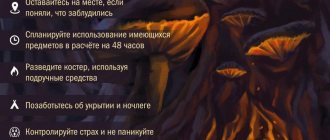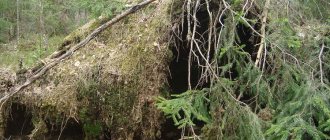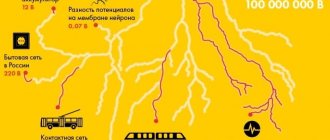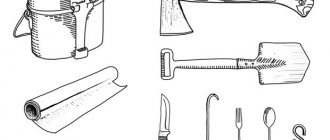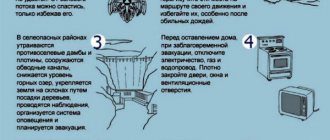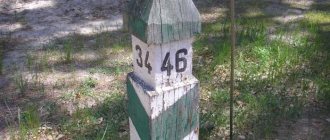How to avoid becoming the culprit of a forest fire
Prevention is the best remedy. Every responsible citizen is obliged to remember about fire prevention measures in the forest, especially during the fire season.
- make a fire,
- use open fire,
- throw cigarette butts on the ground,
- burn grass, hay, fluff under trees or on forest lawns,
- burn grass in fields that are located close to the forest,
- leave glass, cans, bottles in well-lit areas in the forest,
- drive through the forest in a car if its fuel system is faulty,
- throwing things and objects oiled with fuel into the forest,
- use gun wads made of flammable materials when hunting.
- organize fires only in permitted places;
- in the absence of special places for a fire, you should prepare a site for the fireplace, thoroughly clearing it (and the surrounding area) of litter (dry grass, branches, etc.);
- completely extinguish the fire after yourself, clean the resting place.
- If fire spreads uncontrollably from the fire, extinguish the flame using water, earth, sand, and freshly plucked branches of deciduous trees.
Non-anthropogenic causes of fire include lightning striking trees, spontaneous combustion of peat chips, etc.
How to behave in the event of a fire in the forest or if a source of fire is detected.
If you were careless and a fire did occur, do not waste a minute.
- if there is water nearby, fill the fire;
- water all nearby plants, this will help prevent the fire from spreading;
- you can make a broom from green branches and sweep the edge of the fire from the side, inclined towards the flame, while turning the broom all the time;
- throw damp, loose earth over the fire, you can try to dig around the burning area;
- if you managed to extinguish the fire, do not be lazy to report it to the forestry department;
- If you can’t cope on your own, don’t stop trying and wait for the rescue service.
If you find a fire in the forest, the first thing you need to do is to report the location of the fire to the forest guard, administration, police, and rescuers:
- single telephone number: 01
- from a mobile phone: 112.
If the fire has not yet gained strength, then take measures to extinguish it with the help of water, earth, sand, branches of deciduous trees, and thick clothing. The most effective way to extinguish a forest fire is to cover the edge of the fire with earth.
If the fire gets too hot and you are unable to stop it, leave the scene immediately.
Preventive measures in the fight against natural fires.
Preventive actions in case of a forest fire are carried out to protect the population and prevent the spread of fire from the forest to populated areas. To do this, during massive fires, clearings and dirt strips are laid and cleared.
The width of the stripes ranges from 5 to 10 meters in mixed forests and 50 meters in coniferous forests. Trenches are dug around populated areas and filled with water so that the fire does not spread from the forest to the residential sector.
In populated areas there must be fire ponds or other bodies of water, the capacity of which must be at least 30 cubic meters for each hectare of area of the populated area.
If there is a threat of a strong fire in a forest or peat bog, the population organizes a vigil to monitor the situation near the border of a populated area. Additional clearing of soil strips between the forest area and the residential sector must be carried out to ensure the necessary safety of people in case of fire.
Expert opinion
Makarov Igor Tarasovich
Hunter and fisherman with 20 years of experience. Wildlife lover
Fire reservoirs are filled at the rate of 10 liters of water per 1 meter of forest edge length. You should also check the condition of wells and additional reservoirs, which can also be used in case of danger.
The population is advised to prepare cotton-gauze bandages, respirators or other respiratory protection. During the dry season, a ban or restrictions on visiting the forest are introduced, especially in cars with an internal combustion engine.
This is interesting: How to make snowmobile skis with your own hands?
Why shouldn't you litter in the forest?
23.03.13, 11:04
Why shouldn't you litter in the forest?

Spring. Forest. Ecology
With the onset of spring, many people try to go out into nature to relax, breathe fresh air and have fun. It happens that when a vacation ends, mountains of garbage are left in the forests after people have been there. People don't think about cleaning up the place where they rested. They also do not think about their responsibility to nature and the fact that garbage does not decompose within 24 hours, much less evaporate. And those who like to “get away quickly” will next time find another clean place to relax and mess it up again.
Why shouldn't you litter in the forest?
Firstly, littering in the forest is simply unethical and unsightly.
Secondly, during the process of decomposition, chemical elements enter the soil and groundwater, then into springs. Various chemicals react with each other and can have unpredictable effects on human health.
Thirdly, animals go to “tourist” landfills in search of food. Together with food, they absorb cellophane and other indigestible objects, which leads to their death.
Fourthly, broken glass in the forest can easily injure children, tourists, mushroom pickers, and even animals.
Forest protection engineer Alexander Vladimirovich Reshetnikov answers our questions
— How do you assess the cleanliness in the forests of the Vinogradovsky branch?
If we talk about the sanitary condition of forests in the Ramensky Voskresensky district, then we need to pay attention to several factors. Firstly, these are natural reasons. There is a lot of dead wood in the forest. An inspection of the sanitary condition of forest plantations was carried out on the territory of the branch. The volumes of drying and bark beetle-damaged plantings that are subject to sanitary felling have been established; sanitary and health measures are planned and their implementation in tree stands. The work of ensuring sanitary safety is entrusted to forestry workers. Timely work on harvesting dead wood is aimed primarily at combating forest pests.
Secondly, the human factor. It happens that people who visit forests leave garbage behind and do not follow fire safety rules. For example, 90% of the fires in 2010 were caused by people. Although in places of public recreation there are specially designated areas where you can leave garbage, even in this case there are those who do not do this. This is especially true for young people.
— What is the ecological culture of the area’s residents? Does it need to be raised?
Let's first define what ecological culture is. Ecological culture is environmental education, a conscious attitude towards nature and practical participation in improving environmental management. An important component of ecological culture is a personal and value-based attitude towards nature, which helps to realize oneself as a part of nature and one’s responsibility for the consequences of communication with it. In our area, the environmental culture of citizens as a whole is not at the proper level, although in the last few years it has begun to grow. I think that the forest fires of 2010 provided lessons for this - residents of the area became more conscious of their stay in the forest. But despite this, even today there are people who leave behind garbage in recreation areas. This speaks of their carelessness, negligence and low human culture in general.
It must be said that work in this direction is constantly being carried out: environmental rallies and camps are held, work is underway with schoolchildren in the forestry areas of the region. Those. Part of the solution to the problem of increasing environmental culture lies in education. The formation of an environmental culture in the learning process is the optimal form of environmental education. Also, branch employees regularly make trips to forests and lakes, where they conduct explanatory work with people right on the spot. It is necessary to promote and raise environmental issues in the media. This is not to say that this does not exist, but more attention needs to be paid to it.
Fire theory
Forest burning is the uncontrolled spread of fire. The forest itself has no sources of fire. About 8% of fires are caused by natural factors. They could be lightning or severe drought.
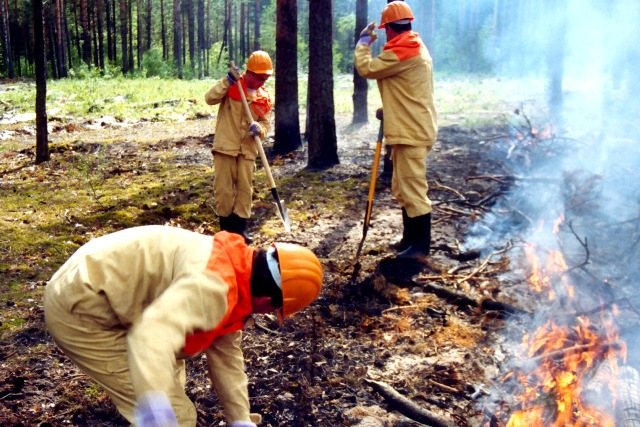
In all other cases, the forest burns due to the fault of man or subsequently his activities in the forest.
If the height of the flame does not rise above 2.5 m, then the fire is of a grassroots nature. If the crowns of trees are burning - the horseman. The spread of a crown fire at a speed of up to 70 km/h is called a crown hurricane fire. If peat burns underground, it is called underground.
Anyone caught in a fire may experience severe oxygen deprivation from smoke . At the same time, he loses orientation in space and can be injured by falling trees.
Memo "Safety rules in the forest"
Before a walk in the forest
- Be sure to communicate your plans . Agree on a contact time/return time. If you live alone, find someone who will know exactly where you are going and when to start worrying.
- Wear bright clothes , preferably with reflective elements. It is especially important to give such a set to your elderly relatives if they like to go mushroom picking. It is doubly important if these are grandparents who take children with them. In addition, it is advisable to take a raincoat or a large trash bag.
- Take a fully charged phone with you. It's good to have an extra external battery with you.
- Bring a bottle of water, a chocolate or energy bar, a compass, a whistle, and lighters. This little kit is compact and can save your life . If you regularly take any medications , be sure to take them with you into the forest.

What to watch out for in the forest:
- Be careful, poison! As everyone knows, mushrooms, berries and plants in the forest can be poisonous. You should not pick mushrooms, herbs or berries if you are not sure about them.
- Annoying and dangerous insects. Before going into the forest, wear long sleeves and tuck your pants into your socks. In general, the body should be completely covered. It is better to choose clothes that are slippery, so that it is more difficult for insects to crawl on them, and light-colored, making them easier to notice. And after the forest, be completely and thoroughly checked.
- Wild animals. When you catch an animal in the forest, try to appear invisible to it. Slowly and carefully move back, preferably facing him. And if he does see you and is coming straight at you, you will have to take action. Each animal is different.
Bear - stay calm, back away slowly, move back (do not turn your back), scream loudly, never look the animal in the eyes, he will perceive this as aggression on your part. Take a jacket or sweater in your hand and lift it above your head, this will increase your size in the eyes of a predator. If all of the above doesn't help, then play dead. The bear can sniff you, hit you with its paw, can jump on you with its front paws, etc. As a rule, bears lose interest in such an “enemy” and leave (provided you lie still).

Wolf - if you meet a wolf in the forest, try to climb a tree (the best option). Do not look the animal in the eyes (he perceives this as a challenge and danger on your part). If he does attack you, put your hand forward; it is advisable to wrap your hand in a cloth, sweater or jacket so that the animal cannot bite through it. Protect your neck. If you have a knife at hand, strike at the carotid artery (the fur of a wolf is not so easy to penetrate), at the body, trying to hit the heart. If there is no knife, strike the nose, eyes, and ridge. Moose - get off his path, speak softly calmly, as if you were talking to a small child, don’t shout, go behind a large tree, the moose may simply lose sight of you. If the elk still attacks, then pretend to be dead, curling up in a ball.
The wild boar is afraid of sharp sounds and whistles; as a rule, it quickly runs away from such sounds. This is a very fast animal that is difficult to escape from; the best option is to hide in a tree. If an animal knocks you to the ground, try to group yourself, protecting your internal organs, and cover your stomach with your backpack.

- Be careful not to drown! No one has yet ruled out a swamp in the forest. Therefore, if you see an area in the forest overgrown with reeds, do not approach it. And when you feel the water under your feet, go back.
- To get lost in the forest. If you get lost, act according to the rules.
If you are lost:

- Panic is your main enemy. You may start frantically rushing through the forest looking for a way and getting even more lost. As soon as you realize you are lost, stop. Think about where you came from, whether you can hear screams, car noise, barking dogs, etc.
- Call to report what happened, and then save your phone charge. Remember that charging your phone can save your life . Don't call everyone at once. Call 112 or immediately the Lisa Alert squad. Briefly communicate what you can and wait for help without talking to anyone else. You can turn off the phone (if the battery is already running low) by calling 112 to agree on the time of the next contact. Remember, the number 112 or the inscription “SOS / Emergency call” always works on all phones, regardless of the presence of a signal and account balance.
- Make some noise. You can shout “Aw!”, and then be sure to knock on the tree with a stick . The source of the knocking is easier to determine, because it does not create the same echo as a human voice. Start shouting and knocking as early as possible if you are walking with a group. This way they will find you faster. This will also help you scare away any wild animals that may be nearby.
- Look around carefully. If you can clearly see the road, go out onto it. It will be easier to find you here. But remember that you don’t need to run around and look for it everywhere. Only move away from your location if you can clearly see the road or train tracks directly in front of you.
- Have a snack. If help does not come for a very long time, you can snack on plants known to you . The edible leaves include clover, and the rhizomes of cattails and reeds can be eaten. You can look for wild raspberries and blackberries. But remember that some plants and berries can cause allergies and gastrointestinal problems, so use them only as a last resort.
- bright piece of clothing with you . And clothing with reflective elements significantly speeds up night searches.
- You can only approach bodies of water if you are confident in your abilities.
- Take a compass with you and determine the cardinal directions when entering the forest. The direction is determined as follows: you need to combine the colored end of the arrow with the letter N (north), and remember the number that will indicate the entrance to the forest. You need to return towards the number, which is located on the other side of the dial (opposite direction). Teach your children how to use a compass, it's easy.
- Build a fire. The most dangerous thing in the forest is to freeze. In summer by 18:00, and in winter by 15:00 you should start preparing for the night. Preparing firewood will take a lot of time, and walking through the forest in the dark will no longer be possible. Light a fire, dry your clothes if they are wet, and warm up. To do this, you must have a lighter or flint with you. Regular matches may get wet. It’s also good to have a raincoat or a large garbage bag with you: they will protect you from the rain and create additional warmth.
- It is best to sleep during daylight hours , and at night listen carefully to the call of search engines. It is not recommended to move in the dark; you can trip and get injured or fall into the water. Choose a place to spend the night that is high and dry, preferably near a large tree. Prepare brushwood for the fire, make bedding from spruce branches. It is best to sit with your back to a tree, light a fire in front of you and keep it going all night.
- When you've been in the forest for a long time and still haven't lit a fire, try connecting your thumb and little finger . If you cannot do this without effort, this is an alarming symptom that means the onset of hypothermia. We urgently need to warm ourselves up in any way possible.
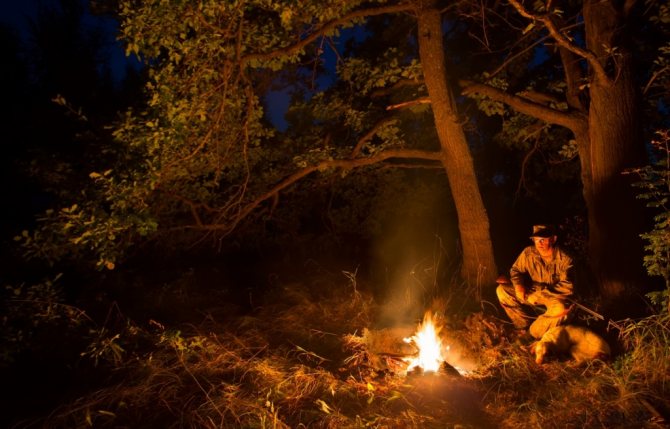
Try not to go into the forest alone, this will give you a better chance of survival in emergency situations..
I wish you a pleasant walk. Take care of yourself!
Algorithm of actions
First of all, if a forest area is on fire and the current situation is present, you should not visit the forest in order to obtain information about the impending threat. And before any trip during a fire-hazardous time of year, it is necessary to assess the situation and possible risks. But if, after all, you are caught in a fire in the forest, then let’s look at a possible algorithm of action.
- firstly, do not panic and try to assess as competently as possible the area, location and strength of the fire that has arisen;
- secondly, in case of a small fire, take available extinguishing measures: jackets, brooms made of green branches. And if you have a tool, throw earth at the edge of the fire.
It is important to remember that a pedestrian walks through the forest at a speed of no more than 5 km/h, and if there are obstacles, this speed is even lower.
The fire spreads at a speed of more than 10 km/h, it is impossible to overtake the spreading disaster, so evacuation actions must be started in a timely manner.
- if the situation gets out of control, you should notify those in the forest by all available means and gather the group in a relatively safe place. After this, determine the direction of the wind and choose the direction of movement: against the wind, perpendicular to the line of fire;
- If possible, look for access to a river, an open field, a road or a clearing. And in case of heavy smoke, try not to lose orientation, control the composition of the group and keep an eye on those lagging behind;
- it may happen that at some point in time the line of fire becomes narrow enough to pass through. Try to overcome it by covering your head and body with wet clothes;
- after leaving the area covered by fire, inform the Ministry of Emergency Situations, warn the local administration and forestry.
Waste classification
Any garbage in the forest is dangerous due to its toxicity and has an individual decomposition period. There are 2 main groups:
- Organic waste. Nature is rich in organic substances, and humans encounter them. During the decomposition process, they release substances that provoke the proliferation of bacteria harmful to nature. For some animals, rotting organic matter is comparable to poison. This type of waste includes products containing carbohydrates, cellulose, and manure waste.
- Inorganic waste. This waste does not rot for a long time, thereby polluting nature. These include: furniture, iron, mirrors, construction waste, auto parts. In contact with the ground, such garbage causes colossal damage to it, subsequently forming ravines. If you bury waste of inorganic origin, the problem will only increase, because due to prolonged decomposition, toxins will enter the soil, water and air.
The state allows garbage to be thrown only into special bins, garbage cans and containers. Anything thrown outside of them is punishable by administrative penalties. The Administrative Code states that it is prohibited to leave garbage on roads (roads, railways) and in forest areas.
Disposal methods
You can avoid problems with the law and conscience by properly disposing of garbage. Each type of waste has different methods.
- Paper, cardboard, bio packaging. It is better to burn this type of garbage in a fire. After disposal is completed, cover the site of the fire with earth, so the ashes will not scatter throughout the area, and the surface of the earth will recover faster.
- Food waste. This is an organic type of waste that rots for a short time. To destroy it, remove the turf under the bush, dig a hole, place waste there, bury it and return the turf under the bush. After this, pour it with plenty of water. The food that rots after 2-3 weeks will become plant food. The main thing is to separate the waste from plastic and bags before burying it.
- Metal waste. Tin cans are made of thin metal, so they oxidize in a short time, mainly upon contact with water. In order for the jar to decompose faster, the anti-corrosion coating is removed from it and lowered into the fire. After processing, the jar needs to be reduced and buried like food waste. Under the influence of the atmosphere, it quickly oxidizes and will not cause damage to nature.
- Plastic. This type of waste will harm the environment in any case. It is not recommended to take it when going outdoors; the contents can be transferred to glass or iron containers, which will be easier to dispose of. You can’t treat plastic like paper; when it comes into contact with fire, it releases toxic gas, which will lead to poisoning. Opinions about its toxicity differ, but there will definitely be no benefit from it.
- Glass. It is impossible to burn it, but in fire it is perfectly deformed. After firing, the glass is dipped in water to improve its fragility, dried and crumbled into sand. You should not break glass without fire treatment, as this can injure a person or animal. There is no need to take items made from such material with you into nature.
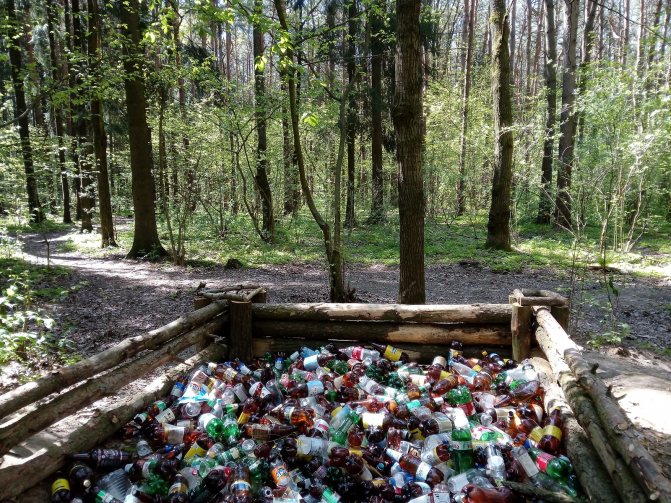
Systemic problems with garbage in the forest give rise to many methods of dealing with it:
- In every city there are waste recycling plants that are capable of recycling any waste. In addition to the fact that factories save the environment from pollution, they “give” a second life to some materials.
- Municipal institutions hire people to remove garbage on city streets and in forests. These people save the earth from the consequences of decomposition of organic and inorganic waste.
- High fines are established, prescribed in regulatory documents.
- Various garbage collection campaigns are held, where volunteers clean up the forest, streets, and roads.
If it's impossible to escape
But there are situations when exiting the ring of fire is not possible. And only one thing is clear - you will have to stay in the ring of fire until the fire passes.
In this situation, it is best to find a body of water and enter it, or simply find a low-lying place. In this case, you need to clear the space as much as possible from flammable objects and lie down on the ground. If possible, find a natural depression, cover your head with clothes, and try to wait out the passage of the fire.
In this case, you must throw away all the stones, as they can become hot and cause burns. Try to calmly wait for help to arrive, without trying to leave the ring on your own.
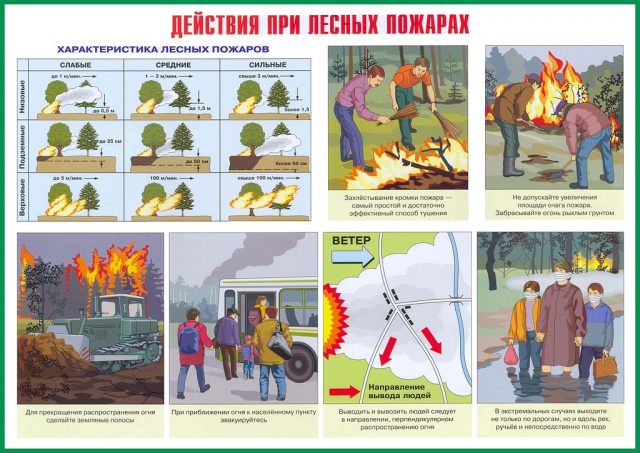
The disaster threatens the village
The greatest threat from fire is to residents of villages located near the forest. Therefore, during fire-hazardous times of the year, it is necessary to promptly create special breaks, both from the border of the forest area and within it. And also monitor the arrangement of special reservoirs for extinguishing fire.
In order to prevent the threat of fire, preventive and explanatory work is carried out with the population. Local residents are warned to observe fire safety in the forest. And when planning a visit to forest areas, groups of tourists warn the local forestry department and provide information about their route and the composition of the group.
Prevention
We must remember that it is always better to prevent a fire than to later waste human and material resources on its elimination and restoration of damaged areas. A few simple rules will help you avoid big trouble:
- do not throw cigarette butts or matches in the forest;
- tidy up the picnic area: put out the fire, remove garbage, including broken bottles;
- During production activities, do not leave flammable waste.
Remember that the life and health of other people depends on your behavior in following the rules!
A fire is the uncontrolled spread of fire. It causes not only the destruction of material objects, but also the death of people. You were resting, and you were caught in a forest fire. What to do? Follow a few simple rules of behavior and you will understand how to act in an emergency.
This is interesting: Wolf pit: wolf hunting is encouraged in Kazakhstan
What to do, how to be?
Man is a child of nature, and he, this child, really wants to go to the forest: listen to the birds singing, inhale the pine aroma and soak his feet in the coolness of the stream. The principle that all tourists should be guided by is very simple: all changes that were made to the ecosystem by your appearance should tend to zero. And you can start with garbage. Do not leave garbage in the forest, pick it up and throw it in a trash container. You'll be surprised how simple it really is.
Why is it easier to carry food and drink bottles into the forest than to pick up empty bottles and leftover food? This is an unsolved paradox. And now the decision is ripe - burn everything! Let’s assume that by burning garbage you did not pollute the atmosphere (although it is clear to everyone that this is not the case). What do we have left? Food and paper were burnt. The plastic has melted, because it doesn’t burn, and now nothing will ever grow at the site of the fire. The fire did not cause any damage to the iron and glass. Excellent disposal of garbage in the forest!
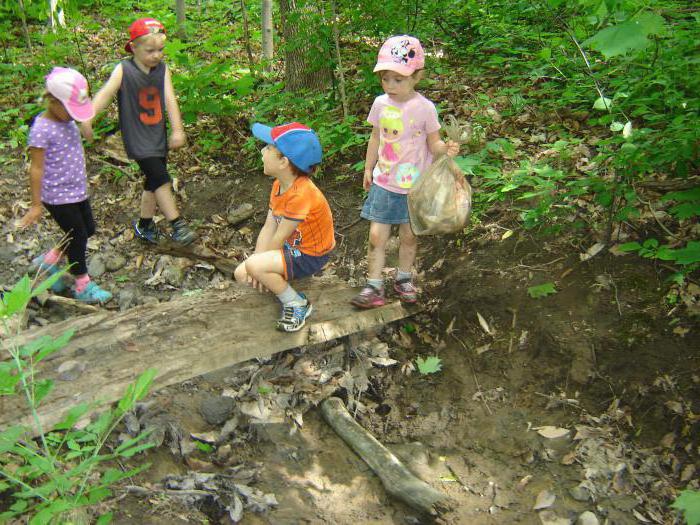
Another solution is to bury it! It's troublesome, but we'll try. It’s good if this is a place of mass recreation. After all, if tourists come here after you, and rotting remains are buried all around, then most likely they won’t like it. Let's explore the rest. Paper and food will still rot. Plastic takes about 200 years to decompose and during all these years it evaporates toxic substances. Iron and glass will keep company with plastic. Is this how we clean up trash in the forest?
We thought and thought and decided. What if you collect everything and put it in a pile? After all, there are services that monitor the forest - they will collect it. Still better than burning and burying. This is how huge garbage dumps are formed in the forest. A second, third, and so on will be added to one package. If a tourist is a conscious, environmentally educated person, he will choose the first option - he will take everything he owns with him, thereby preventing the pollution of forests with garbage.
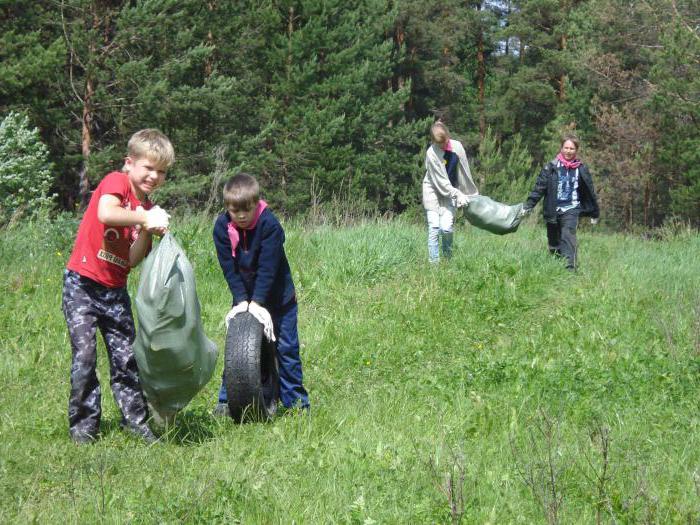
One of us cannot stop deforestation on the planet, cannot reduce the number of cars that poison the atmosphere and prevent the disappearance and destruction of animals and plants. But everyone can throw rubbish in the trash can, avoid picking snowdrops and make a bird feeder. If every person takes care of the world around him, of the piece of the planet in his apartment and in the clearing where he just rested, the Earth will respond to all of us with love and beauty. Big things always start small. If every person says to himself “The planet is in my hands” and turns on individual environmental consciousness, won’t the whole world become happier, more colorful and cleaner?
DRIVERS
If you go into the forest by car, be sure to take fire prevention measures. Drivers should remember...
· smoke or build a fire near your iron horse;
· leave all kinds of garbage soaked in gasoline, oil, kerosene.
· equip the engine with a spark arrester;
· leave cleaning rags in specially designated areas.
When performing such simple actions, minimal harm is caused to our green friend - the forest.
TYPES OF CAMPFIRE:
· hut (in the form of a house with kindling inside), convenient for cooking, night lighting, requires little firewood;
· well (in the form of a wooden frame, square, kindling inside), suitable for cooking, has a wide, low flame;
· star (thick branches folded crosswise), suitable for a night fire, does not require continuous attention, just move the logs towards the center;
· taiga (a powerful fire made of thick logs stacked on top of each other with a lining of wood chips), burns well for up to 10 hours, heats, scares away animals;
· hunting (three medium logs on a lining), burns for up to 8 hours, does not require special supervision;
· Polynesian (or pit), the safest fire, produces a lot of ash, economical;
· nadya (made of 3 thick and long logs, lying in the letter H), gives a lot of heat, which is regulated by moving the logs.
BREEDING
To skillfully make a fire in the forest, you need to remember a few basic steps:
· careful selection of the breeding site must be carried out;
Expert opinion
Makarov Igor Tarasovich
Hunter and fisherman with 20 years of experience. Wildlife lover
Any mistake when setting up a fire can destroy the ecological balance. For example, the heat of a fire near trees will greatly heat their bark and living tissue. The tree may die. Soil heated to high temperatures bakes and becomes lifeless.
There are a number of rules for a “safe fire”:
1. in dry weather, light a fire only on sand or stone, along the banks of reservoirs, in clearings with green grass;
2. remove all flammable objects from the fire at a distance of more than half a meter;
3. For emergency fire extinguishing, keep several containers of water nearby;
4. Place a bunch of chopped branches nearby to smother the fire;
5. never light a fire near resinous trees, near trees with hollows, or in old clearings;
6. Dense grass, moss, and lichen can cause fires in surrounding trees;
7. do not build high and large fires: several small ones can bring you more benefit;
8. if you see an old fireplace, use it;
9. If you do not find a suitable place, remove the top layer of soil with turf and light a fire on the ground without an organic substrate.
10. Build a fire at least three meters from the tents on the leeward side.
Don’t forget, if you are in a protected forest, there will definitely be a fire pit. Unauthorized transfer of it is punishable by law.
Making fire in the forest: 5 reliable ways to survive.
If the matches are damp or have run out, and you need to somehow make a fire, don’t worry, there are many ways to start a fire using improvised means.
Method 1 – optical.
Since school, we have known how to ignite paper using a magnifying glass and sunlight. But not everyone knows that this optical effect also works with other objects.
If you forgot to take a magnifying glass with you on a hike, then a camera lens (have you forgotten that?) or binocular or glasses lenses focused on dry tinder will allow you to achieve the same effect.
If you don’t have a camera or binoculars, you can improvise a lens yourself. To do this, fill a transparent plastic bag with water, focus the sun's rays passing through the bag into one point and keep it in one place. When the tinder begins to smolder, fan it slightly.
A clear bottle of water or even a piece of ice will also work for this method.
Another option is to use a flashlight reflector. To do this, you need to disassemble your flashlight, remove the reflector, insert dry grass or a dry flower into the hole in the center and point the reflector at the sun. The reflected rays will ignite the dried flower, from which you can set fire to the tinder.
Method 2 – electric.
If there is no sun, but you have a spare flashlight, you can use it.
To do this, you need to remove the protective glass and remove the light bulb. Carefully crush the glass, the main thing is not to touch the filament or touch the tungsten spring. We insert it back into the flashlight without covering it with the protective glass, and carefully place dry grass around the filament. We press the power button, literally after a few seconds the grass ignites.
If you do everything carefully without damaging the filament, you can use this method more than once.
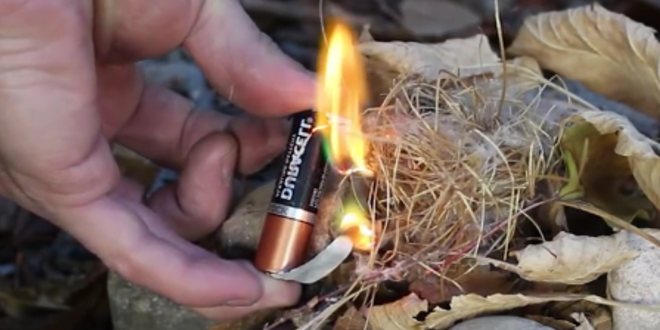
Surely you have AA batteries. With their help you can also make fire.
To do this, you will need something dry and flammable (for example, cotton wool or lint), a battery, a piece of foil paper (such as the inside of a cigarette pack), scissors or a knife.
Using scissors, we cut the foil so that the ends are wide and in the middle there is the narrowest place, no more than 2 mm. We put our fuel in this place, connect the ends of the tape with the foil down to the poles of the battery. The fuel ignites. We put it in tinder and carefully inflate it.
Method 3 – chemical:
The following compositions ignite independently when mixed, when rubbed with stones or under the end of a wooden rod, with the help of which fire is produced by friction. When mixing them, care should be taken to avoid contact with metal and store in a dry place.
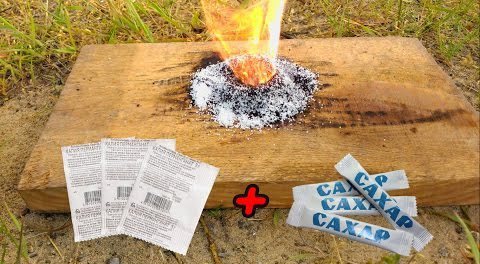
- Potassium chlorate and sugar in a ratio of 3:1
- Potassium permanganate (potassium permanganate) and sugar in a ratio of 9:1
- Sodium chlorate and sugar in a ratio of 3:1
- Potassium permanganate (potassium permanganate) and antifreeze - a little flammable material is folded into a sheet of paper, potassium permanganate is poured in and a few drops of antifreeze are added. All this is wrapped in paper. Within a minute, an oxidation reaction occurs with a large release of heat.
- Potassium permanganate (potassium permanganate) and glycerin - place a flammable material (napkin, cotton wool, dead wood) on top of the kindling. Then pour potassium permanganate and add 1-2 drops of glycerin. After 10-15 seconds, a small smoke appears, which gradually increases, then sudden spontaneous combustion occurs.
Potassium chloride is included in some tablets used to treat throat diseases. Potassium permanganate (potassium permanganate) and glycerin may be in your medicine cabinet. Sodium chloride is a herbicide.
Method 4 – prehistoric:
If you have nothing at all except an axe, but there are forests and branches around, you don’t have to worry, you can start a fire with this set.
The force of friction is a great thing.
Use a knife or ax to make a V-shaped notch in the hardwood base. Make a small indentation next to the notch. As a rotating rod, use a piece of a hollow stick made of soft wood, preferably cone-shaped, with the wide part under the palms and the narrow part at the base. Roll the rod between your palms, pressing it into the indentation.
When the tip of the rod becomes red hot from friction, bring it to the tinder and fan the fire. To increase friction, pour a pinch of sand into the cavity of the rod.
The same method, but slightly improved - “fire bow” .
Make a small indentation near the edge of the base.
From below, under the recess, cut out a cavity for the tinder. Give the rod that will have to be rotated a cylindrical shape. Make a bow from a flexible branch and a rawhide strap, twine or shoelace.
Use a notched stone or a piece of wood with a groove cut into it to press down on top of the rod as it rotates. Wrap the bow string around the shaft once. Place the bow in the recess of the base, and lightly press it on top with a stone or piece of wood prepared for this purpose. Move the bow back and forth to give the shaft a rotating motion.
When the rod begins to go deeper into the soft wooden base, increase the rotation speed. When the rod penetrates the cavity, increase the pressure on it and speed up the movements of the bow even more. Try to keep the shaft upright while working the bow evenly. You can stand on a wooden base with one foot.
Continue working the bow until the hot tip of the bow hits the tinder. Blow lightly on it to ignite the fire.
Method 5 – sparkling:
If you have flint on your farm, then half the battle is already done.
All you have to do is find the right kindling material, a windy place, persistence and patience.
Dry grass, feathers, fluff, dry moss, napkins, cotton wool, etc. can be used as kindling material.
It is best to take care of the ignition at home and prepare wax cotton pads.
To do this, you will need ordinary cotton pads, wax or paraffin, a container for melting wax, tweezers, and a sheet for drying the discs. First of all, you need to melt the wax to a liquid state. Then we take a cotton pad with tweezers and dip it into liquid wax; you don’t need to hold it for a long time. Remove from the wax and place on a sheet of paper to dry.
How to use it: The wax cotton pad becomes quite hard, you need to break it on several sides and tear it a little on one. The inside of the disc is left unsoaked and fluffy, so it will quickly ignite with a spark, and the wax will maintain the combustion for about 5 minutes. During this time you will have time to light a fire.
Taking silicon with you is much safer than matches, because matches can become damp.
Among our products you can find a convenient multifunctional survival kit, which necessarily includes silicon.

We also offer a universal tactical shovel, with which you can not only dig, saw, chop, but also easily start a fire.

Of course, every outdoor enthusiast has his own methods of making fire, developed through invaluable experience. Share your reliable methods - do not let inexperienced tourists perish from cold and hunger))
FUEL SELECTION
Before going into the forest, you hardly think about choosing kindling. Well, if you're lucky, you'll get a fire quickly. But what is better to use to light a fire?
Kindling is a highly flammable material. They must be dry. It is important to remember that dead wood burns quickly and brightly, but smokes. Dry pine needles burn well, but they fly off into sparks, which creates a fire hazard. Fresh pine needles, although they burn, produce a lot of smoke. It will be harmful to your eyes and your clothes.
· dry reeds, ferns, lichens, moss and grass rolled into a bundle;
One day, while walking through the forest, I thought that the forest was not so safe. This world, separate from civilization and the bustle of the city, makes you think a little: there is complete silence and many dangers that can await us at every step. There are predators and poisonous plants... But that's not all! After thinking carefully, I decided to tell you about the possible dangers in the forest, and what measures should be taken.
Safety rules in the forest are the first thing you should think about when going mushroom or berry picking, or just taking a walk through the same forest expanses. But the forest is beautiful and wonderful, and the air is pleasant and fresh... But at the same time, dangers cannot be ruled out. Unfortunately, there are often cases when people, having gone into the forest, disappear or die, often for unknown reasons... Although this does not mean that you will definitely run into danger, it is still worth protecting yourself.
Now let's take a closer look at what awaits us in the forest, and what to do about it.
Be careful, poison!
As everyone knows, mushrooms and berries in the forest can be both edible and inedible. If you are hungry, you should not rush to all sorts of “goodies” without knowing their names. It is better to take food with you, taken from home or bought at the store. It will be safer this way. As an option, you can take sandwiches: here you don’t need to take much, and you’ll eat well. And don’t forget about water, because going without drinking for a long time is also not an option.
Delusion - the most famous case in the forest
Before going into the forest, take with you everything you need: a compass, a navigator, a small first aid kit (bandage, cotton wool, hydrogen peroxide), a knife, a plastic raincoat. Always remember the area you are in. And if you do get lost, try to make notches in the trees so as not to walk in circles. In general, there are plenty of ways to get out of the forest. Read about it here. In this case, the main thing is not to panic and act according to the rules.
Annoying and dangerous insects
Mosquitoes, midges, ticks, there are so many of them... Before going into the forest, wear long sleeves and tuck your pants into your socks. In general, the body should be completely covered. It is better to choose clothes that are slippery, so that it is more difficult for insects to crawl on them, and not very dark, so that they are easier to notice. Mosquito and tick repellents are also helpful! And after the forest, check carefully. And stay away from power lines; that's where the most ticks are.
Wild animals
There may be bears, wolves, and wild boars in the forest, there are a lot of them there... Therefore, be on your guard: take something to eat with you, not only for yourself, but also for the animals. And if you find an animal in the forest, try to appear invisible to it. Slowly and carefully move back, preferably facing him. And if he does see you and is coming straight at you, you will have to take action. Each animal is different. Read more about this in this article.
Be careful not to drown!
Not only animals and plants can be dangerous in the forest. No one has yet ruled out a swamp in the forest. Therefore, if you see an area in the forest overgrown with reeds, do not approach it. And when you feel the water under your feet, go back. And don’t try to pretend to be a hero and try to step there or go further, otherwise you may get sucked in so much that it won’t seem like much! But if you find yourself in a quagmire alone, the chances of salvation will be almost zero.
Ups and downs
Walking through the forest, there is a high chance of stumbling upon an unexploded military shell. But there have been some of them left there since the Second World War - mom, don’t worry. Some of them were buried by partisans to destroy the Nazis, and some landed from combat vehicles and remained there to this day. So if you see anything rusty or that looks like ammunition, don't touch it. Stay out of harm's way. Better yet, call the Ministry of Emergency Situations so that the shell can be neutralized.
So, after reading the above, keep it all in your memory as the apple of your eye if you are planning to go into the forest. But that's not all! In the forest it is still possible (rarely, but quite possible):
- Get shot by a hunter
- Get hit by a falling tree
- Fall into a pit full of wolves
- Run into a maniac or forester
- Meet the goblin
Yes, and try not to go into the forest alone, this will give you a better chance of salvation in emergency situations. I wish you a pleasant walk. Take care of yourself!
